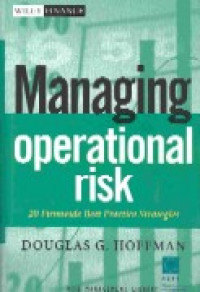
Managing operational risk : 20 firmwide best practice strategies
| Gmd : Text
| Availability :
| 00000009670 | HG173 .H585 2002 REF | (Reference) | Available - Ada |
| 00000009869 | HG173 .H585 2002 REF | (Reference) | Available - Ada |
Published in association with the Global Association of Risk Professionals. As e-commerce and globalization continue to expand, so does the level of operational risk, increasing the need for guidance on how to measure and manage it. This is the definitive guide to managing operational risk in financial institutions. Written in a concise, no-nonsense style, and containing numerous real-life case studies, it covers all the bases from the basics of what operational risk is to how to design and implement sophisticated operational risk management systems. Readers will appreciate the up-to-the-minute coverage of the latest techniques and practices to manage operational risk. They will learn how to enhance their positions in the face of anticipated new regulatory standards and capital requirements.
Definitive guide to managing operational risk in financial institutions. Covers all the bases from the basics of what operational risk is to how to design and implement sophisticated operational risk management systems.
From the Inside Flap
For today?s financial institutions, Managing Operational Risk has the essential business tools to design optimal risk management programs and put your company well ahead of the curve in the face of anticipated new regulatory standards and capital requirements. This definitive book by an international expert covers every aspect of managing operational risk, including operational risk definitions, data collection, risk assessment, modeling, insurance, and risk finance, as well as a comprehensive introduction to information technology.
The complete evolution of operational risk management is covered here, including guidelines for setting objectives consistent with a corporate vision, educating management and staff on how to deal with operational risks, coordinating operational risk management functions, outlining various approaches to risk assessment and measurement, and examining techniques for responding to operational risk. This book supplements its descriptions by presenting varied approaches to each of the 20 featured strategies along with alternative tools and tactics for program development, so you can decide which management systems are best for your company. The author goes well beyond the usual downside-only perspective on operational risk management to explore the upside benefits of an effective enterprise-wide program. Each chapter is generously supplemented with cases that illustrate proven techniques, and cautions against techniques that have not been successful. In addition, financial considerations are addressed, including developing economic capital and regulatory models, insurance and risk finance, as well as risk-adjusted performance measures.
With a concluding synopsis of chapter highlights and lessons learned for easy skimming and quick reference, this is an essential resource for operational risk managers as well as CEOs and CFOs at investment and commercial banks, brokerages, insurance companies, mutual fund companies, and their e-business affiliates and subsidiaries.
Managing Operational Risk is the answer for executives and operational risk managers of financial firms who want to establish the best policies for bridling operational risk at a firmwide and enterprise-wide level. The techniques and practices presented here include:
* Dynamic risk monitoring and reporting implement a continuum of data and risk tools for effective identification, assessment, mitigation, and finance
* Risk assessment, modeling, and risk-adjusted performance measures calculate, monitor, and manage the effects of operational losses on firmwide and business unit levels
* Operational risk technology and systems ensure program efficiency by leveraging technology in enterprise-wide data gathering
* Market perception develop a plan and ongoing discipline for protecting corporate integrity and managing crises that may impact a firm?s reputation, brand, or franchise
* Insurance and risk finance programs design, evaluate, and fine-tune insurance and developing financial programs for operational risks
Table of Contents:
Introduction.
Operational Risk Management 101: An Executive Summary.
The Best Practice Strategies.
What is Operational Risk?
The Real Opportunity: Creating More Effective Companies.
Operational Risk and Market Perception: Franchise, Reputation, and Brand Risk.
The Enterprise-Wide Framework: Corporate Governance, Mandate, and Roles.
The Operational Risk Management Group.
Risk Response Framework and Strategies.
Risk Assessment Strategies.
Database and Consortia: Working Through the Details.
Risk Indicators and Scorecards: Cornerstones for Operational Risk Monitoring.
Operational Risk Analysis and Measurement: Practical Building Blocks.
Dynamic Risk Profiling and Monitoring.
Insurance and Operational Risks: Aligning Conventional Programs.
Operational Risk Finance: The Re-Engineering Process.
Economic Risk Capital Modeling: Allocation and Attribution.
Regulatory Capital and Supervision.
An Operational Risk Management Case Study: Managing Internet Banking Risk.
Operational Risk Technology and Systems.
The Game Plan and Action Steps.
Additional Readings.
Operational Risk Management: Bibliography of Sources.
Endnotes.
Index.
About the author
Douglas G. Hoffman (Fairfield, CT) is an independent consultant in operational risk management. His firm, Operational Risk Advisors, provides executive training and assists financial institutions and
corporate clients worldwide in operational risk analysis and mitigation.
| Series Title |
Wiley Finance Series
|
|---|---|
| Call Number |
HG173 .H585 2002 REF
|
| Publisher Place | Hoboken |
| Collation |
xxxvi, 534p.; 24cm.
|
| Language |
English
|
| ISBN/ISSN |
0471412686
|
| Classification |
HG173
|
| Media Type |
-
|
|---|---|
| Carrier Type |
-
|
| Edition |
-
|
| Subject(s) | |
| Specific Info |
-
|
| Statement |
-
|
| Content Type |
-
|
No other version available







